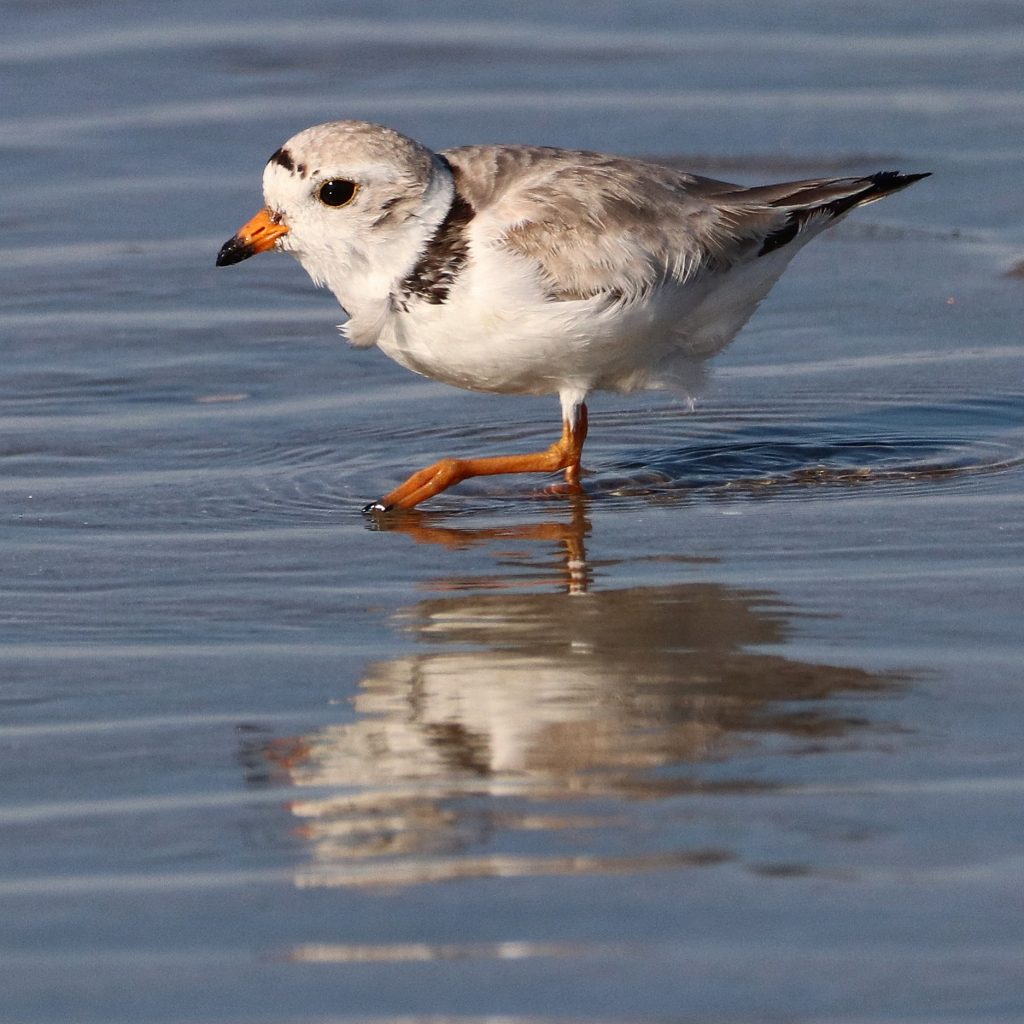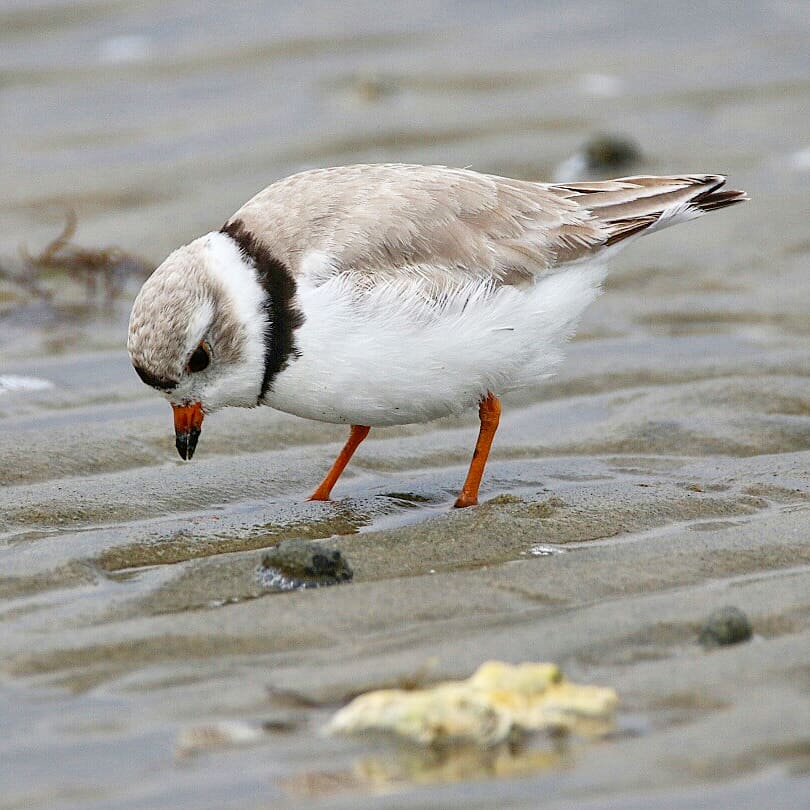Photos by Stewart Ting Chong
When paddling close to shore along Crane’s Beach in Ipswich in early summer, take note of a small pale shorebird scurrying on little orange legs along the water’s edge like a wind-up toy. You can identify the Piping Plover (Charadrius melodus) by its white breast, grayish back, single black necklace, and orange bill with a black tip.
It can be hard to distinguish the Piping Plover from the Semipalmated Plover (darker with bigger black necklace).
 The Piping Plovers’ summer breeding habitat spreads out along a couple of miles of shore, where lower dune habitat close to shore is optimal. They dash from the tideline to their shallow nest scrapes on the dunes’ edges above the high tide line. They forage alone or in small groups sticking to higher part of the shoreline compared to other shorebirds. They stand on one foot and stir the other foot in the sand to scare up prey, according to ornithologist David Sibley.
The Piping Plovers’ summer breeding habitat spreads out along a couple of miles of shore, where lower dune habitat close to shore is optimal. They dash from the tideline to their shallow nest scrapes on the dunes’ edges above the high tide line. They forage alone or in small groups sticking to higher part of the shoreline compared to other shorebirds. They stand on one foot and stir the other foot in the sand to scare up prey, according to ornithologist David Sibley.
Crane’s Beach, like many other beaches along the Massachusetts coast, have roped off areas to protect nesting plovers and terns from beach goers. The aggressive Least Terns aid in plover nest protection by dive bombing passersby.
The Piping Plover peeps loudly, hence its name. It is a visual hunter, and stands alert and upright hunting prey using its large black eyes, then scurries to another spot and abruptly stops again. Sometimes it just stands and waits.
The birds arrive mid-March and choose their nesting site by early April. They make a bunch of scrapes in the sand about four inches in diameter before they settle on one in some kind of debris. The best defense for this vulnerable shallow nest is camouflage of cream-colored eggs with brownish black splotches.
Like many ground-nesting birds, they have a broken-wing display where they feign injury to distract a predator away from a nest or fledgling. They lay one egg, followed by another egg every other day for up to an average of four eggs. The eggs hatch within 25-27 days.
Chicks look like little gray fuzzballs on stilts. They are precocial and are up and running around and looking for food (worms, mollusks, insects) the first day they hatch, led by their parents.
They leave early August, headed back to their winter grounds in the Caribbean.
Next beach north from Crane’s, Plum Island closes its beach entirely starting April 1 and usually reopens around July 1. A small area at Parking Lot #1 stays open.
The small, adorable bird is fighting a beach battle on three fronts: beach goers who by walking by can disturb nesting and feeding (also no kite flying allowed, dog walking, drones); predators including crows, raptors, gulls, coyotes, skunks, racoons, and foxes; and the coastal environment high tides in storm surges that wipe out shallow nests accelerating due to climate change. Low profile beach sends water way back into the primary dune vegetation.
Dave Rimmer, Essex County Greenbelt, describes past efforts. “More than once in my time managing nesting Piping Plovers, a storm surge washed out a nest on the beach, scattering the eggs and obliterating the nest. We would often be able to recover some or all of the undamaged eggs within 12-24 hours and return then to the general area of the old nest, create a small depression in the sand by hand, replace the eggs, and have the pair resume incubation and successfully hatch the eggs. Obviously that extended period of cooling did not ‘kill’ the eggs, but more than likely just put a pause on development.”
Thanks to protection from the Trustees of Reservations, Piping Plovers have managed to thrive at Crane’s Beach. Also a wide beach helps allow wildlife and humans to coexist.
But that proliferation has taken decades.
In 1970, just three pairs nested on the beach. The Trustees initiated a protection program in 1986 when five pairs produced five chicks. From those five pairs, populations increased fairly steadily. Three decades later, Crane’s sees an average of 32 pair nesting each year, but the number can vary widely. In 2019, the Crane’s Beach population had a record year with 49 pairs of plovers, fledging 96 chicks, according to Jeffrey Denoncour, Trustees Coastal Ecologist.
Two other good years were in 1999, when 44 pairs hatched 89 fledglings. The following year, 45 pairs hatched only 12 chicks when the storms were really bad. In 2018 and 2017, the beach saw 30-40 pairs, which is really excellent for these birds. Plum Island (next beach to the north) is also seeing numbers increase.
Beyond Crane’s Beach, the Piping Plover’s plight extends to their winter grounds and migration routes south. Fortunately many countries are working to help sustain and grow populations with various measures.
Along the Atlantic coast the Piping Plover is listed as federally threatened, but conservation efforts have helped stabilize populations.
Tips: To help, limit disturbance, watch the birds from a distance. Your best bet at seeing them is to land your kayak at either ends of the beach beyond the swim zones, then walk along the shore. May, June, and July are prime months for spotting them.
Put-In: To reach Crane’s, you have two launch options. Put in at the Ipswich Town Dock and paddle down the Ipswich River and out the mouth, then turn right. You can also put in at Pavilion Beach, at the end of Jeffrey’s Neck Road on Little Neck. Hand-carried boats are allowed on the beach’s north end. Turn right, paddle across the mouth of the Ipswich River, then keep going along the shore. Continue along the shore beyond the swimming buoys, then make your way close to shore again after the spit. A fun trip is a circumnavigation of Crane’s Beach and Castle Neck, nine miles total, where you paddle along Crane’s Beach, turn into the mouth of the Essex River, and follow the Castle Neck River through the Fox Creek Canal, past Castle Hill and so back to your launch at the town dock or Pavilion Beach.
In summer, beware of motor boats and stay close to shore. The mouth of the Ipswich River can be hard to paddle against the tide and opposing wind and tide will generate waves. Crane’s Beach generally has mild surf, but according to what the sandbar is doing at the spit, you may have to paddle out aways to avoid breaking surf at the end of the spit.

